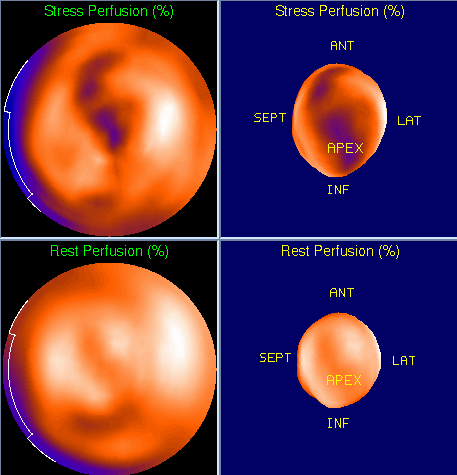Case Author(s): Mark Fister, M.D. and Rob Gropler, M.D. , 9/20/00 . Rating: #D2, #Q4
Diagnosis: Adenosine-induced ischemia with transient left ventricular enlargement
Brief history:
44 year old man with nonexertional nocturnal chest pain presents for evaluation prior to spine surgery.
Images:

Bull's eye exercise and stress images with 3D representation.
View main image(mi) in a separate image viewer
View second image(mi).
Multiplanar perfusion images, Stress above Rest.
Full history/Diagnosis is available below
Diagnosis: Adenosine-induced ischemia with transient left ventricular enlargement
Full history:
44 year old man with nonexertional nocturnal chest pain presents for evaluation prior to spine surgery. The patient suffers from diabetes mellitus, hypertension, and obesity and has a family but no personal history of heart disease. The ECG portion of the adenosine stress examination was negative for ischemia.
Radiopharmaceutical:
Thallium-201 i.v., and Tc-99m Sestamibi i.v.
Findings:
Dual isotope myocardial perfusion rest/adenosine stress SPECT images demonstrate a moderate-sized completely reversible perfusion defect of moderate to marked severity involving the distal anterior and anteroseptal walls and extending into the apex. Gated Tc-99m sestamibi images demonstrate hypokinesis of this ischemic region, as well as adenosine-induced left ventricular enlargement.
Discussion:
Not only is it important to examine myocardial perfusion studies for discrete perfusion abnormalities, but markers of overall ventricular function should also be sought. Transient stress-induced left ventricular enlargement, as demonstrated in this case, is one such example. Though a poor prognostic indicator in itself, the finding is particularly concerning in this case as it is induced with adenosine, a vasodilator. This implies more severe disease and connotes a poorer prognosis than would similar findings in response to the chronotropic and inotropic effects of exercise.
Transiently increased lung activity would similarly result from transient ventricular dysfunction and have similar prognostic significance.
Reference: Thrall JH, Ziessman HA. Nuclear Medicine, the Requisites. Mosby, St. Louis, 1995. Pp. 64-66
Followup:
Cardiac catheterization revealed a 95% mid LAD stenosis. A right coronary injection revealed retrograde filling of the distal LAD via apical collaterals. Angioplasty and stent placement were performed with good angiographic results and resolution of symptoms.
View followup image(an).
Left and right coronary angiograms.
Major teaching point(s):
In addition to identifying discrete cardiac perfusion abnormalities, markers of overall ventricular function, including transient LVE and increased pulmonary activity, should be assessed.
ACR Codes and Keywords:
References and General Discussion of Myocardial Imaging (Anatomic field:Heart and Great Vessels, Category:Organ specific)
Search for similar cases.
Edit this case
Add comments about this case
Return to the Teaching File home page.
Case number: mi018
Copyright by Wash U MO

